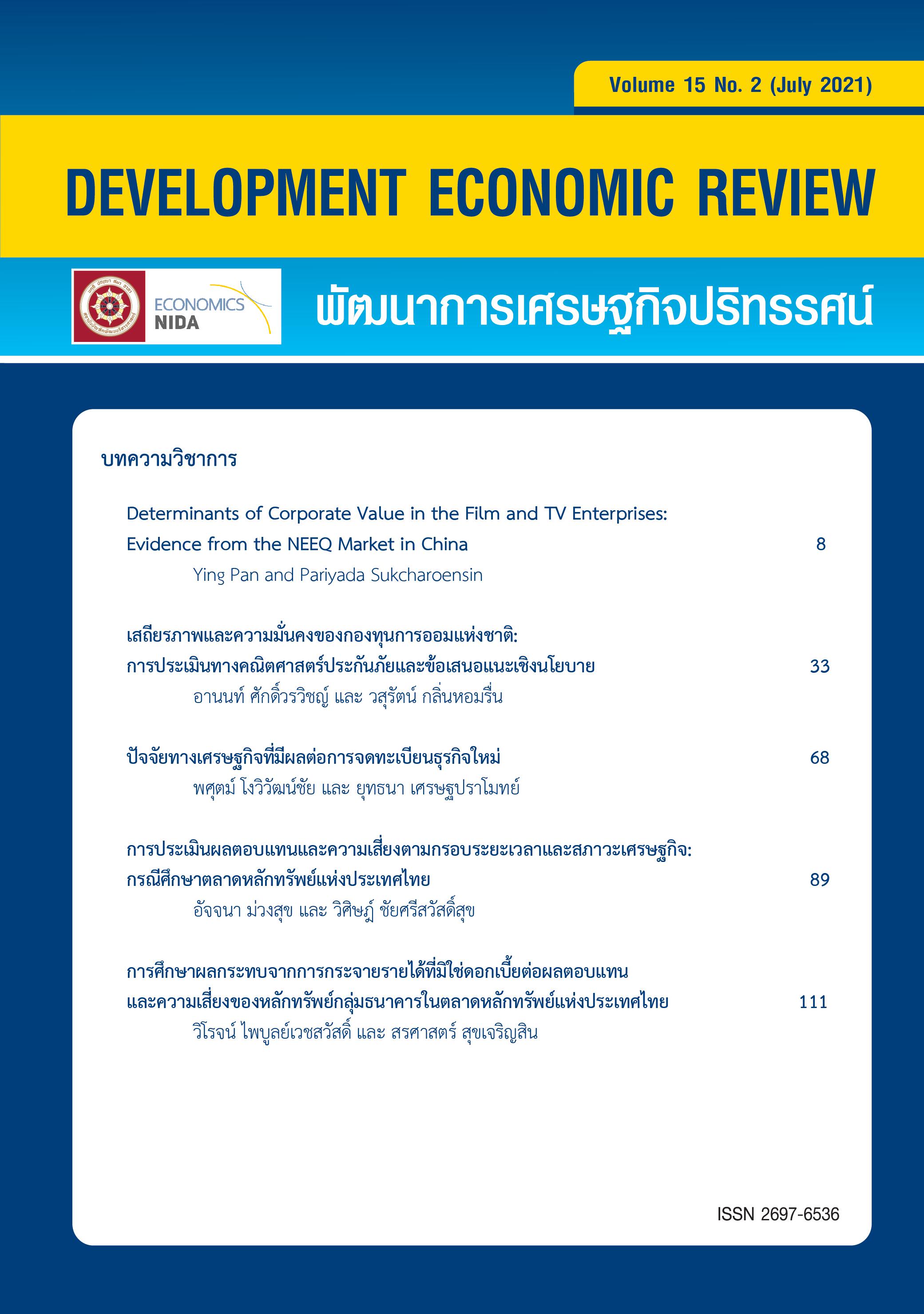An Evaluation of Return and Risk Based on Investment Period and Economic Condition: A Case Study in the Stock Exchange of Thailand
Keywords:
Stock Selection Strategy, Investment Period, Economic ConditionAbstract
A purpose of this research is made for creating and suggesting stock selection strategy for investment based on investment period and economic states. The strategy was created from comparing ROA, PBV, and PE ratio between each company from SET and the mean / median of the business. And then will create portfolio based on Markowitz's theory. The results of the study showed that short-term investors who can accept risk taking in low level, and high medium to very high level are suggested to use the stock selection strategy of group 3. Investors who can accept risk taking in low medium level are suggested to use the stock selection strategy of group 25. For investors who have holding period stocks 5 and 10 years are suggested to use stock selection strategy of group 3 which is the only group generating the highest return in every risk level acceptance. For part of stock selection strategy based on economic states. If economic condition is expanding, investors who can accept risk taking in low medium to very high level are supposed to use stock selection strategy of group 35 and ought to choose group 11 for low risk level. Under the economic slowdown condition, investors who can accept risk taking in high to very high level are suggested to use the stock selection strategy of group 19. Other investors who can accept risk taking in low to high medium level are suggested to use the stock selection strategy of group 31 which can generate the highest return.
References
Chhaya, G., & Nigam, P. (2015). Value Investing with Price-Earnings Ratio in India. IUP Journal of Applied Finance, 21(2), 34-48.
Cho, S.-S., Shin, J.-S., & Byun, J. (2012). The Value of a Two-Dimensional Value Investment Strategy: Evidence from the Korean Stock Market. Emerging Markets Finance and Trade, 48(sup2), 58-81. doi:10.2753/REE1540-496X48S204.
Choi, B. P., & Mukherji, S. (2010). Optimal Portfolios For Different Holding Periods. Journal of Business & Economics Research, 8(10), 1-6. doi:10.19030/jber.v8i10.768
Jensen, G. R., & Mercer, J. M. (2003). New evidence on optimal asset allocation. Financial Review, 38(3), 435-454. doi:10.1111/1540-6288.00054
Kwag, S.-W., & Whi, S. (2006). Value investing and the business cycle. Journal Of Financial Planning -Denver-, 19(1), 64-71.
Lambrechts, H., & Roos, M. (2017). Applying Joel Greenblatt's value investment strategy to the Johannesburg Stock Exchange. Bestuursdinamika / Management Dynamics, 26(1), 2-15.
Leivo, T., & Pätäri, E. (2009). The impact of holding period length on value portfolio performance in the finnish stock markets. Journal of Money, Investment and Banking, 2(8), 71-86.
Li, B., Liu, B., Bianchi, R., & Su, J.-J. (2012). Stock returns and holding periods. JASSA The Finsia Journal of Applied Finance(2), 43-48.
Noma, M. (2010). Value investing and financial statement analysis. Hitotsubashi Journal of Commerce and Management, 44(1), 29-46. doi:10.15057/18701
Sareewiwatthana, P., & Janin, P. (2017). Tests of quantitativeinvesting strategies of famous investors: Case of Thailand. InvestmentManagement and Financial Innovations, 14(3), 218-226. doi:10.21511/imfi.14(3-1).2017.06
Sareewiwatthana, P. (2013). Common financial ratios and value investing in Thailand. Journal of Finance and Investment Analysis, 2(3), 69-85.
Vanstraceele, P., & Allaeys, L. (2010). Studying different Systematic Value Investing Strategies on the Eurozone stock market.
Ye, Y. (2013). Application of the stock selection criteria of three value investors, Benjamin Graham, Peter Lynch, and Joel Greenblatt: A case of shanghai stock exchange from 2006 to 2011. International Journal of Scientific and Research Publications,, 3(8), 1-7.
นิธิชัย ปึงตระกูล. (2558). กลยุทธ์ในการลงทุนโดยใช้อัตราส่วนสำคัญทางการเงินเพื่อแบ่งแยกบริษัทที่ให้อัตราผลตอบแทนมากกว่าตลาด (winners) และ บริษัทที่ให้อัตราผลตอบแทนน้อยกว่าตลาด (losers) (วิทยานิพนธ์ปริญญามหาบัณฑิต). มหาวิทยาลัยธรรมศาสตร์, กรุงเทพฯ.
ไพบูลย์ เสรีวิวัฒนา. (2558). การลงทุนแบบเน้นคุณค่าในประเทศไทยประเด็นของจำนวนหุ้นและระยะเวลาการถือครองที่เหมาะสม. วารสารบริหาธุรกิจ นิด้า, 16(พฤษภาคม), 5-25.
รุจิเรศ แซ่อื้อ. (2560). การวิเคราะห์อัตราผลตอบแทนของพอร์ตการลงทุนที่ประกอบด้วยสินทรัพย์หลายประเภทและมีระยะเวลาของการปรับพอร์ตการลงทุนที่แตกต่างกัน (การค้นคว้าอิสระปริญญามหาบัณฑิต). มหาวิทยาลัยธรรมศาสตร์, กรุงเทพฯ.
วรรณวรางค์ ศรีนวกุล. (2560). เมจิกฟอร์มูล่าและอัตราส่วนทางการเงินในกลุ่มตลาดหลักทรัพย์เอ็มเอไอ (การค้นคว้าอิสระปริญญามหาบัณฑิต). มหาวิทยาลัยธรรมศาสตร์, กรุงเทพฯ.
ตลาดหลักทรัพย์แห่งประเทศไทย. (2557). ตลาดการเงินและการลงทุนในหลักทรัพย์: หลักสูตรผู้แนะนำการลงทุนด้านหลักทรัพย์ (พิมพ์ครั้งที่ 19 ฉบับปรับปรุง). กรุงเทพฯ: ศูนย์ส่งเสริมการพัฒนาความรู้ตลาดทุน ตลาดหลักทรัพย์แห่งประเทศไทย.

Downloads
Published
Issue
Section
License
Copyright to published manuscripts becomes the property of the Graduate School of Development Economics, National Institute of Development Administration. Reproduction of all or part of a Development Economic Review (DER) article by anyone, excluding author(s), is prohibited, unless receiving our permission.
Disclaimer: Opinions expressed in articles published in this journal are those of the author (s) and do nto necessarily represent opinions of the Graduate School of Development Economics, National Institute of Development Administration. Trade and proprietary names are only for identification and not constitute our endorsement.

